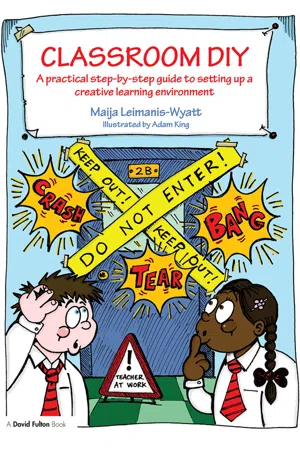
Classroom DIY
A Practical Step-by-Step Guide to Setting up a Creative Learning Environment
- 120 pages
- English
- ePUB (mobile friendly)
- Available on iOS & Android
Classroom DIY
A Practical Step-by-Step Guide to Setting up a Creative Learning Environment
About This Book
Setting up the classroom is a fundamental part of a teacher's job, as a well-planned, aesthetically pleasing environment encourages children to learn and helps with classroom management. However, knowing how to create this environment is not instinctive and teachers are given little guidance, yet are expected to create a stimulating environment that is conducive to learning. The task can often be daunting and time-consuming, and teachers don't know where to begin.
Classroom DIY provides teachers with the answer to these problems. A practical, step-by-step guide, written from firsthand experience, Classroom DIY will enable any primary teacher to make a spectacular job of setting up their room using any materials they have available. Guiding teachers through the process of setting up their space from planning to practice, this book includes advice on:
-
- laying out the room: what furniture to use and where best to position it
- organising areas for specific subjects, including maths, literacy, science and humanities
- how to create an inspiring classroom on a budget: recycling items for use in the classroom and the homemade approach
- how the learning environment can inspire and motivate pupils to learn, taking into account multiple intelligences and routines
- meeting the expectations of senior management teams.
With 'teachers' tales' from a range of individuals in different schools and case studies illustrating solutions to teachers' specific problems with their classrooms, this book is must have for all newly qualified and practising teachers looking to inspire their pupils to learn through their classroom environment.
Frequently asked questions
Information
PART 1
Getting started
INTRODUCTION

Why bother?
Learn from my experience
What you will get from this guide
Chapter 1
THE BIG PICTURE
Two steps forward, one step back
Table of contents
- CONTENTS
- ACKNOWLEDGEMENTS
- PART 1 Getting started
- PART 2 Setting up
- PART 3 Finishing the job